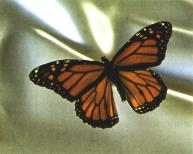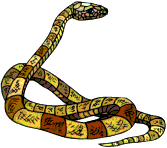The Design of Mimicry
 We
were walking through the brush and a snake appeared in front of us. It
was a beautiful snake with alternating red and black and yellow bands.
My immediate reaction was, "Get away, that's a coral snake." Coral
snakes are deadly. They have a venom that is a nerve agent, and their
bite is nearly always lethal. The man I was walking with was a local
person who knew the area and the snakes. He laughed and said as he
picked up the snake, "No, this is just a friendly old harmless king
snake." I looked in a book when I got home and saw the two snakes in
pictures to be almost identical. The Sonoran mountain king snake is so
much like the coral snake, it is hard to tell the difference. Side by
side in the pictures I could see the difference, but I am not sure in
the wild that I could do so.
We
were walking through the brush and a snake appeared in front of us. It
was a beautiful snake with alternating red and black and yellow bands.
My immediate reaction was, "Get away, that's a coral snake." Coral
snakes are deadly. They have a venom that is a nerve agent, and their
bite is nearly always lethal. The man I was walking with was a local
person who knew the area and the snakes. He laughed and said as he
picked up the snake, "No, this is just a friendly old harmless king
snake." I looked in a book when I got home and saw the two snakes in
pictures to be almost identical. The Sonoran mountain king snake is so
much like the coral snake, it is hard to tell the difference. Side by
side in the pictures I could see the difference, but I am not sure in
the wild that I could do so.
 The question is "how
does this mimicry come about?" This is not an area in which trial and
error can be proposed, because a single bite from a coral snake removes
the learner from the gene
pool. Many times in nature, an animal survives because they look like
some other animal that is deadly or has undesirable characteristics.
There are some butterflies that look like a monarch butterfly, and
since monarchs have a bitter taste that birds do not like, the
look-alike butterflies are also protected. In the case of the coral
snake, it appears that there is a conscious design which promotes the
survival of the king snake.
The question is "how
does this mimicry come about?" This is not an area in which trial and
error can be proposed, because a single bite from a coral snake removes
the learner from the gene
pool. Many times in nature, an animal survives because they look like
some other animal that is deadly or has undesirable characteristics.
There are some butterflies that look like a monarch butterfly, and
since monarchs have a bitter taste that birds do not like, the
look-alike butterflies are also protected. In the case of the coral
snake, it appears that there is a conscious design which promotes the
survival of the king snake.
Recently researchers at the University of North Carolina at Chapel
Hill put brightly-banded plasticine models of snakes in areas where
there were coral snakes and also in areas where there were no coral
snakes. When raccoons, coatis, foxes, coyotes, skunks and bears bit
into the models, they left tooth marks. There were far fewer bites on
the models left in areas where there were coral snakes than in areas
where coral snakes did not exist. It is obvious that predators have
learned to avoid anything that looks like a coral snake and so the king
snake's mimicry is definitely a protective device.
 To enable animals to
survive on the earth and yet not over-populate their food resources,
there has to be a delicate balance between predation and protection
against being eaten. Mimicry seems to be a very well-thought-out way
to keep the balance for many forms of life. We can see God's wisdom
and planning through the things He has made (Romans 1:19-22).
To enable animals to
survive on the earth and yet not over-populate their food resources,
there has to be a delicate balance between predation and protection
against being eaten. Mimicry seems to be a very well-thought-out way
to keep the balance for many forms of life. We can see God's wisdom
and planning through the things He has made (Romans 1:19-22).
--Reference: Natural History, June, 2001, page
18.
Back to Contents Does God Exist?,
JulAug03.
 The question is "how
does this mimicry come about?" This is not an area in which trial and
error can be proposed, because a single bite from a coral snake removes
the learner from the gene
pool. Many times in nature, an animal survives because they look like
some other animal that is deadly or has undesirable characteristics.
There are some butterflies that look like a monarch butterfly, and
since monarchs have a bitter taste that birds do not like, the
look-alike butterflies are also protected. In the case of the coral
snake, it appears that there is a conscious design which promotes the
survival of the king snake.
The question is "how
does this mimicry come about?" This is not an area in which trial and
error can be proposed, because a single bite from a coral snake removes
the learner from the gene
pool. Many times in nature, an animal survives because they look like
some other animal that is deadly or has undesirable characteristics.
There are some butterflies that look like a monarch butterfly, and
since monarchs have a bitter taste that birds do not like, the
look-alike butterflies are also protected. In the case of the coral
snake, it appears that there is a conscious design which promotes the
survival of the king snake.  We
were walking through the brush and a snake appeared in front of us. It
was a beautiful snake with alternating red and black and yellow bands.
My immediate reaction was, "Get away, that's a coral snake." Coral
snakes are deadly. They have a venom that is a nerve agent, and their
bite is nearly always lethal. The man I was walking with was a local
person who knew the area and the snakes. He laughed and said as he
picked up the snake, "No, this is just a friendly old harmless king
snake." I looked in a book when I got home and saw the two snakes in
pictures to be almost identical. The Sonoran mountain king snake is so
much like the coral snake, it is hard to tell the difference. Side by
side in the pictures I could see the difference, but I am not sure in
the wild that I could do so.
We
were walking through the brush and a snake appeared in front of us. It
was a beautiful snake with alternating red and black and yellow bands.
My immediate reaction was, "Get away, that's a coral snake." Coral
snakes are deadly. They have a venom that is a nerve agent, and their
bite is nearly always lethal. The man I was walking with was a local
person who knew the area and the snakes. He laughed and said as he
picked up the snake, "No, this is just a friendly old harmless king
snake." I looked in a book when I got home and saw the two snakes in
pictures to be almost identical. The Sonoran mountain king snake is so
much like the coral snake, it is hard to tell the difference. Side by
side in the pictures I could see the difference, but I am not sure in
the wild that I could do so.
 To enable animals to
survive on the earth and yet not over-populate their food resources,
there has to be a delicate balance between predation and protection
against being eaten. Mimicry seems to be a very well-thought-out way
to keep the balance for many forms of life. We can see God's wisdom
and planning through the things He has made (
To enable animals to
survive on the earth and yet not over-populate their food resources,
there has to be a delicate balance between predation and protection
against being eaten. Mimicry seems to be a very well-thought-out way
to keep the balance for many forms of life. We can see God's wisdom
and planning through the things He has made (